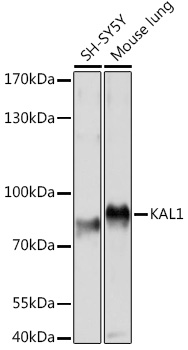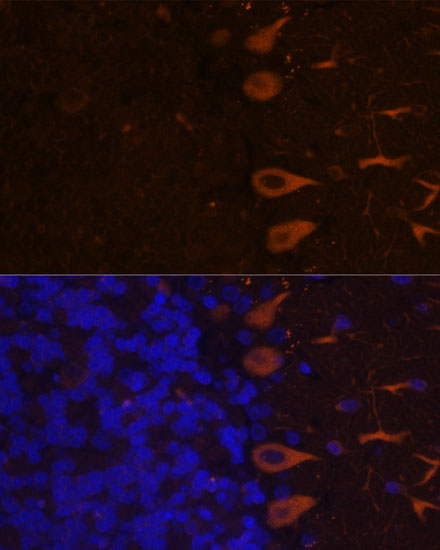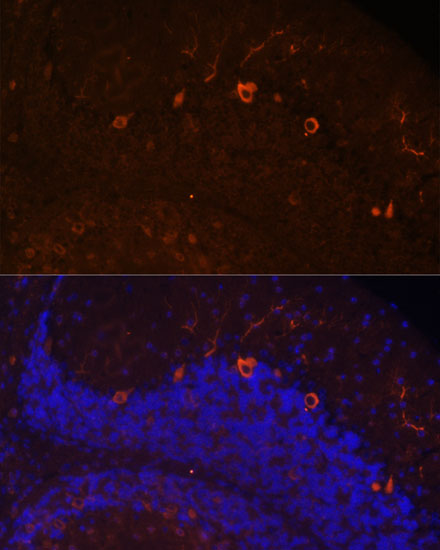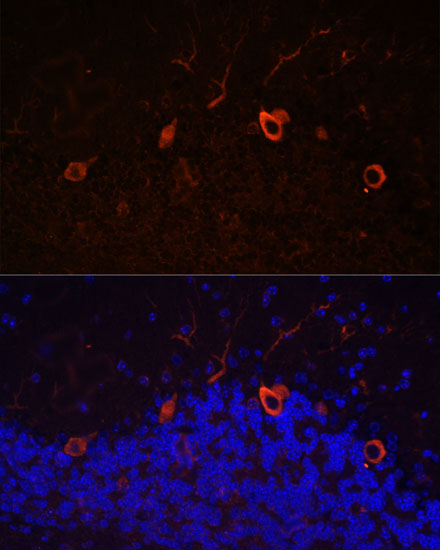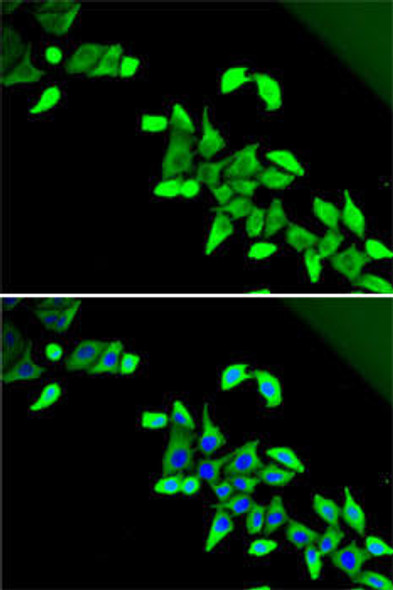Cell Biology Antibodies 7
Anti-KAL1 Antibody (CAB16389)
- SKU:
- CAB16389
- Product Type:
- Antibody
- Reactivity:
- Human
- Reactivity:
- Mouse
- Reactivity:
- Rat
- Host Species:
- Rabbit
- Isotype:
- IgG
- Antibody Type:
- Polyclonal Antibody
- Research Area:
- Cell Biology
Description
| Antibody Name: | Anti-KAL1 Antibody |
| Antibody SKU: | CAB16389 |
| Antibody Size: | 20uL, 50uL, 100uL |
| Application: | WB IF |
| Reactivity: | Human, Mouse, Rat |
| Host Species: | Rabbit |
| Immunogen: | A synthetic peptide corresponding to a sequence within amino acids 200-300 of human KAL1 (NP_000207.2). |
| Application: | WB IF |
| Recommended Dilution: | WB 1:500 - 1:2000 IF 1:50 - 1:200 |
| Reactivity: | Human, Mouse, Rat |
| Positive Samples: | SH-SY5Y, Mouse lung |
| Immunogen: | A synthetic peptide corresponding to a sequence within amino acids 200-300 of human KAL1 (NP_000207.2). |
| Purification Method: | Affinity purification |
| Storage Buffer: | Store at -20'C. Avoid freeze / thaw cycles. Buffer: PBS with 0.02% sodium azide, 50% glycerol, pH7.3. |
| Isotype: | IgG |
| Sequence: | LEVK WSSK FNIS IEPV IYVV QRRW NYGI HPSE DDAT HWQT VAQT TDER VQLT DIRP SRWY QFRV AAVN VHGT RGFT APSK HFRS SKDP SAPP APAN LRLA N |
| Gene ID: | 3730 |
| Uniprot: | P23352 |
| Cellular Location: | Cell membrane, Peripheral membrane protein, Secreted |
| Calculated MW: | 76kDa |
| Observed MW: | 76kDa |
| Synonyms: | ANOS1, ADMLX, HH1, HHA, KAL, KAL1, KALIG-1, KMS, WFDC19, anosmin-1 |
| Background: | Mutations in this gene cause the X-linked Kallmann syndrome. The encoded protein is similar in sequence to proteins known to function in neural cell adhesion and axonal migration. In addition, this cell surface protein is N-glycosylated and may have anti-protease activity. |
| UniProt Protein Function: | KAL1: Has a dual branch-promoting and guidance activity, which may play an important role in the patterning of mitral and tufted cell collaterals to the olfactory cortex. Chemoattractant for fetal olfactory epithelial cells. Defects in KAL1 are the cause of Kallmann syndrome type 1 (KAL1); also known as hypogonadotropic hypogonadism and anosmia. Anosmia or hyposmia is related to the absence or hypoplasia of the olfactory bulbs and tracts. Hypogonadism is due to deficiency in gonadotropin-releasing hormone and probably results from a failure of embryonic migration of gonadotropin- releasing hormone-synthesizing neurons. In some patients other developmental anomalies can be present, which include renal agenesis, cleft lip and/or palate, selective tooth agenesis, and bimanual synkinesis. In some cases anosmia may be absent or inconspicuous. |
| UniProt Protein Details: | Protein type:Motility/polarity/chemotaxis; Extracellular matrix Chromosomal Location of Human Ortholog: Xp22.32 Cellular Component: extracellular region; extracellular space; proteinaceous extracellular matrix Molecular Function:extracellular matrix structural constituent; protein binding Biological Process: axon guidance; cell motility; chemotaxis; fibroblast growth factor receptor signaling pathway Disease: Hypogonadotropic Hypogonadism 1 With Or Without Anosmia |
| NCBI Summary: | Mutations in this gene cause the X-linked Kallmann syndrome. The encoded protein is similar in sequence to proteins known to function in neural cell adhesion and axonal migration. In addition, this cell surface protein is N-glycosylated and may have anti-protease activity. [provided by RefSeq, Jul 2008] |
| UniProt Code: | P23352 |
| NCBI GenInfo Identifier: | 134048661 |
| NCBI Gene ID: | 3730 |
| NCBI Accession: | P23352.3 |
| UniProt Secondary Accession: | P23352,B2RPF8, |
| UniProt Related Accession: | P23352 |
| Molecular Weight: | 76,112 Da |
| NCBI Full Name: | Anosmin-1 |
| NCBI Synonym Full Names: | anosmin 1 |
| NCBI Official Symbol: | ANOS1 |
| NCBI Official Synonym Symbols: | HH1; HHA; KAL; KMS; KAL1; ADMLX; WFDC19; KALIG-1 |
| NCBI Protein Information: | anosmin-1 |
| UniProt Protein Name: | Anosmin-1 |
| UniProt Synonym Protein Names: | Adhesion molecule-like X-linked; Kallmann syndrome protein |
| UniProt Gene Name: | ANOS1 |
| UniProt Entry Name: | KALM_HUMAN |
View AllClose


